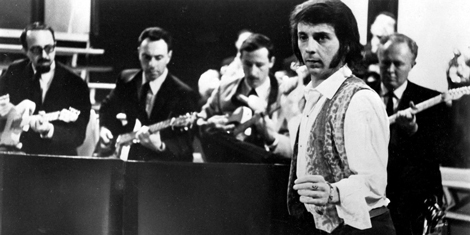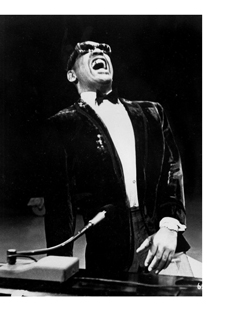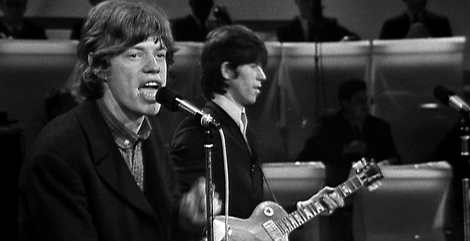The T.A.M.I. Show + The Big T.N.T. Show
For nostalgic excitement there’s no better ’60s pop compendium than this! An impossibly eclectic mix of talent at the Santa Monica Civic, in a brilliantly produced live show recorded in the wonder of Electronovision! The lineup is incredible: The Rolling Stones, James Brown and Lesley Gore on the same stage?

The T.A.M.I. Show; The Big T.N.T. Show
Blu-ray
Shout Select (Shout! Factory)
1964 / B&W / 1:66 & 1:85 widescreen / 112 + 93 min. / Electronovision / Collector’s Edition / Street Date December 2, 2016 / 29.98
Starring T.A.M.I.: The Beach Boys, The Barbarians, Chuck Berry, The Blossoms, James Brown and The Flames, Marvin Gaye, Gerry and the Pacemakers, Lesley Gore, Jan & Dean, Billy J. Kramer and the Dakotas, Smokey Robinson & The Miracles, The Supremes, The Rolling Stones Toni Basil, Glen Campbell, Teri Garr, Jack Nitzsche, Leon Russell, Phil Spector, David Winters. T.N.T. David McCallum, Ray Charles, Petula Clark, Bo Diddley, Joan Baez, Phil Spector, The Ronettes, Roger Miller, The Byrds, Donovan, The Ike & Tina Turner Revue.
Cinematography James E. Kilgore
Film Editors Kent MacKenzie, Bruce Pierce
Go-Go choreography David Winters, Toni Basil
Produced by Lee Savin, William Sargent, Jr.
Directed by Steve Binder
When I was six years old American Bandstand with its dance party format became a TV hit with name singers and acts; and in 1963 or so the booming popularity of teen music prompted TV shows like Shindig, where the performers lip-synched to their songs. The music changed so fast and the music companies became so greedy, that by the time Woodstock rolled around, any name-act rock ‘n’ roll variety show was mostly priced out of range. George Harrison lamented that his charity-oriented Concert for Bangladesh became the victim of record company contract lawyers, who ignored the meaning of the concept, ‘charity.’
But there was one blazing moment of happiness in 1964, when some promoters looking for the best way to exploit a new video-to-film system called Electronovision put together the perfect Rock ‘n’ Roll variety show, aimed to gather the best acts possible from Top-40 radio. The Beatles were out of reach, but talent like The Rolling Stones were not yet quite established. The business hadn’t quite reached the point where every singer or group made elaborate demands for the most simple of appearances. The idea of having one’s performance recorded in a theatrical film was attractive, especially in the company of top stars. The producers invented an idea called the Teenage Awards Music International, from which derived the name of the theatrical release The T.A.M.I. Show.
The T.A.M.I. Show made all the right moves, starting with the hiring of Steve Binder, whose directing choices pay off in every musical number. Where to start? There is, of course, no lip-synching. All the acts are live. The two hours in the show are not that much shorter than the time of the concert itself — what we see is the way it was, and not an editing construct. This means that the build of excitement on stage and the enthusiasm of the teenagers brought in to form the audience, are all real. The acts were also asked to stay backstage at all times, which makes a difference in the psychology — the performers support one another and are acutely aware that their work is being judged by their peers: everybody wants to be as good as they can be. The legendary story of The T.A.M.I. Show is that James Brown’s act stopped the show to such a degree that the Rolling Stones felt at a loss to follow them — which is why we see the Brit band trying its utmost to be as exciting as possible. Mick Jagger dances up a storm, so as not to seem tame by comparison.
The show isn’t just a string of musicians doing sets. Binder counterpoints Chuck Berry and Gerry and the Pacemakers, alternating songs. Sometimes they’re not full songs, but medleys, something that helps when the average Top-40 tune becomes repetitive at the 90-second mark. At this point in the music concert scene each act brings along its own amps and equipment. It’s not like in the ’70s, when three guitars, drums and keyboards require an army of roadies. Adequate rehearsals plus the desire to be cool and not make mistakes results in a really slick flow of acts. Director Binder’s camera plan has it all covered. He brought in top live-show mixers to guarantee great, solid mono sound recordings of the music.
As we learn from his extended interview on the disc, director Steve Binder took the production seriously, even though Electronovision was sort of a souped-up Kinescope process. Four custom-made higher resolution video cameras fed into a switchboard, where the director cut the show on the fly, using only his notes from rehearsals. A video transfer of this final feed became the finished show. The quality is video-like but surprisingly good. Its aspect ratio is already widescreen. James Brown famously refused to rehearse, telling the director, ‘you’ll know what to do.’ This is perhaps why Brown’s act starts wide before moving in. Elsewhere Binder’s directing is inspired – he has the magic touch of knowing when to change cameras. The groups get prime coverage, and shots of the audience aren’t overused. Binder also gets excellent coverage of the corps of Go-Go dancers that work behind the acts, and sometimes with them.
Those Go-Go dancers are the best in the business. Some are from Shindig but their numbers are multiplied with other top talent. We’ve all seen crummy dancers from this period, and your average Go-Go gyrations can become pretty tiresome after a while. Here they’re choreographed by ex- West Side Story Jet David Winter, with Toni Basil assisting. The choreography is nicely matched to the kind of song being performed and the dance moves are sensational. Some of the fast action is actually very exciting, keeping visual interest at a high level.

So The T.A.M.I. Show has two-score of the top names in Pop performing in the best way possible. The show is mostly live and un-manipulated by editorial tricks, so it feels like ‘being there.’
The acts are a dream cross-section of single pop performers, the new group concept, English invaders and Motown hitmakers. All but one or two acts are top names, immediately familiar to every teenager in the audience. Even now it seems unlikely or impossible that this lineup could have been put together. The kids do a lot of screaming for their favorites, just as in A Hard Day’s Night. A lot of Top-40 talent at this time concentrated on studio work to make hit records, but these acts are the kind that can play to an audience. I personally recognize all but The Barbarians. Billy J. Kramer and the Dakotas being the only other group that hasn’t retained household name status.
Concert films almost always have drawbacks, like the occasional sub-par audio in Monterey Pop and the extended Woodstock acts, or inadequate filming coverage, like the weak 16mm blown up to 70mm for Bangladesh. The slight image degradation of Electronovision is not a drawback, and the excellent live TV direction makes the difference, especially in The T.A.M.I. Show. One feels the excitement. The kids present must all have felt their happy little brains exploding, a joy testified to by John Landis on his trailer commentary (included on this disc). Landis’s entire 7th grade class was surprise-transported to the Santa Monica Civic Auditorium to witness the show of their lives. This concert film becomes a vivid experiential flashback, not a souvenir of the show. I was twelve when The T.A.M.I. Show went down so when this show plays I naturally feel transported to a magical time. We feel like we were there too.
In 1964 the kids in the audience probably didn’t know what some of the performers even looked like, the same as me. Jan and Dean aren’t too impressive in person, especially when serving host duties, doing Smothers Brothers-style humor. At age 12 I would have found Chuck Berry intimidating until he smiled, and until I realized that his guitar style was the basis for all my favorite surf music. Gerry & The Pacemakers were always sweet and melodic, with Gerry Marsden’s unchanging, reassuring smile. Smokey Robinson & The Miracles are impossibly smooth performers, with great backup singer choreography. Likewise Marvin Gaye comes off as a charismatic performer of great talent. We’re told that Lesley Gore was the show’s biggest attraction at the time; it’s nice to discover that her singing on the ’45 records wasn’t pasted together — she has a strong voice.
The Beach Boys were at this time already more than a year into stardom, but they still look ridiculously young, like little kids. The economic reality of the music biz made itself felt not soon after its first showings of The T.A.M.I. Show — the Beach Boys’ lawyers managed to get their segment dropped from prints of the show. It’s since been reinstated, from a film source with a slightly different look.
The Supremes sound fine but they’re actually tamer on stage than other contemporary girl groups. Florence Ballard and Mary Wilson project a harmonious charm, and Diana Ross looks as if she’s already trying to distinguish herself. With an enormous beehive hairdo and her tiny face with huge eyes and teeth, she now seems very strange indeed.
After hearing all my life about how electrifying James Brown is in The T.A.M.I. Show, I can now say that the reports weren’t exaggerated. He projects more dance and singing energy than seems humanly possible, and even works a ‘too exhausted to go on’ bit into his act. But this of course guarantees that the Rolling Stones are on their toes, giving a very strong set of five songs.
As explained on the disc extras, the title sequence was shot on film on the streets of Sunset Blvd and Santa Monica;, with most of the acts seen cavorting in imitation of The Beatles. Since this copy of the film is U.K.-sourced, the on-screen title is not The T.A.M.I. Show, but Teen-Age Command Performance.

The follow-up Electronovision film concert The Big T.N.T. Show also features an interesting array of bands performing live. But it soon becomes apparent that it’s nowhere near as successful as its predecessor. Steve Binder couldn’t participate, and new producer Phil Spector ignored the first show’s smart staging concept. Spector organized an orchestra to open and close the concert; it also plays with or behind some of the acts. Instead of just letting the performers do what they do, it looks as if Spector tried to impose his taste and style on everything. TV star David McCallum conducts the orchestra for instrumental versions of the songs “I Can’t Get No” and “1-2-3” which sound like Easy Listening versions. They largely fall flat – watching TV’s Illya Kuryakin acting cool doesn’t build audience excitement.

This show doesn’t appear to have been shot with the idea of retaining the Live TV feed, but is instead edited from more than one performance. One or two individual acts may have been shot without an audience. This deadens things from the start. Cutaways to the audience sometimes reveals jaded, bored high schoolers, not the less inhibited 7th-graders imported for the first movie. Spector does slip some black teens into the stands of Sunset Blvd’s Aquarius Theater, allowing some great shots of non-white girls rocking out in ecstasy at the sight of their favorite stars.
This time the lineup isn’t as inspired — just one year later, the radio scene has been overwhelmed by folk-rock. Some of the music choices tap performers that wouldn’t primarily be teen favorites. Roger Miller and his folksy ditties include the instant-kitsch “England Swings.” Donovan seems tame and repetitive, especially when his slow songs drag out to full length. Petula Clark certainly was popular with kids, and her songs are nicely shot, but her image still seems more appropriate for an ordinary TV variety show.
The disaster is Joan Baez. Looking edited-in, she sings a straight version of a couple of folk songs in a phony ‘gather ’round’ setup with a camera crane. Spector then has Baez perform totally outside her style: while he plays piano backed by the full orchestra, she belts out the Righteous Brothers’ hit “You’ve Lost that Lovin’ Feeling. It’s terrible. It’s typical of Spector decisions that are simply antithetical to a show that’s supposed to be catering to teens. The stage settings this time around are unimpressive and the Go-Go dancers appear to be doing the best they can with insufficient guidance. Before they worked up the audience excitement like cheerleaders, but not here.
There’s no impression of the flow of a real show. The film proceeds in bursts of energy that don’t build, because we’re obviously seeing everything out of order. The Byrds sing three songs one after another, in as flat and dull manner as possible, perhaps without an audience. It’s as if they were trying flip off the little gnome producer Spector.
The energy goes way up with The Loving Spoonful, who are always playful and likeable even when a missed downbeat necessitates a second start to a song. Ray Charles is good as always but has difficulties with the orchestra, perhaps from insufficient rehearsal. Spector’s girl group The Ronettes is terrific, with impressive singing choreography. And show finishers Ike and Tina Turner have tons of energy, even if they’re not attractively photographed.
The touch of an inspired live TV director is missing — the Electronovision cameras too often cut to Tina just as she turns away from us. A.I.P. went cheap on the production, perhaps as if they saw this as one of their Katzman-like ’50s ersatz musicals, the cheapies where groups came in for just a few minutes to lip synch a big hit. The Big T.N.T. Show would perhaps seem better if The T.A.M.I. Show weren’t superior in every respect.

Shout Select’s Blu-ray of The T.A.M.I. Show and The Big T.N.T. Show won’t be out ’till December 2. It’s a delight, especially the first movie; you’ll feel like jumping up and trying to learn some of the dance moves. Once one becomes accustomed to the look of Electronovision it seems more than adequate, and the good sound mixing puts the presentation on a high level. The T.A.M.I. Show is often praised as the best film record of almost every performer in it.
The rights to The T.A.M.I. Show were in limbo for decades, making it only available in cut-down form or on bootlegs. It’s finally back together again, in near-perfect shape.
T.A.M.I. comes with several extras, listed below; I particularly liked the interview video piece with Steve Binder (the packaging only lists his commentary). It’s also nice to have John Landis’s enthusiastic Trailers from Hell trailer commentary present as well; perhaps TFH will amend it to this review.
The T.N.T. extras are three welcome new interviews (below). Best of all is a new 36-page essay in an insert booklet, written by Don Waller. It tells the whole story behind the original shows, politics and all, including a discussion of Electronovision and good hints on how to spot unexpected future music stars and other notables among the musicians and dancers. Do you like the vintage teenage music ‘buzz’ obtained from viewings of A Hard Day’s Night in good quality? The T.A.M.I. Show delivers the same thrill… it makes one feel proud to be a baby boomer.
From the descriptions in Amazon, the Shout! Factory 2010 DVD of The T.A.M.I. Show appears to be the same content, show and extras.
Reviewed by Glenn Erickson
The T.A.M.I. Show; The Big T.N.T. Show
Blu-ray rates:
Movie: T.A.M.I.: Excellent, T.N.T.: Good
Video: Very Good
Sound: Very Good +++
Supplements: T.A.M.I.: Commentary by Steve Binder and Don Waller; interview with Steve Binder; Trailers from Hell trailer with John Landis commentary; original radio spots. T.N.T.: New Interviews with Petula Clark, John Sebastian and Henry Diltz; extra composite interview.
Deaf and Hearing-impaired Friendly? YES; Subtitles: English (feature only; includes song lyrics)
Packaging: Two Blu-ray discs in keep case
Reviewed: November 3, 2016
(5254tami)
Here’s John Landis on The T.A.M.I. Show!
Visit DVD Savant’s Main Column Page
Glenn Erickson answers most reader mail: dvdsavant@mindspring.com
Text © Copyright 2016 Glenn Erickson







